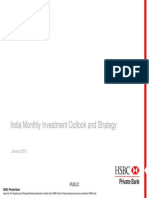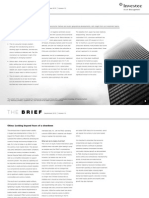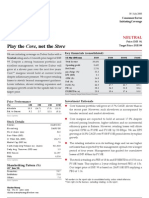Ficc Times: The Week Gone by and The Week Ahead
Ficc Times: The Week Gone by and The Week Ahead
Uploaded by
r_squareCopyright:
Available Formats
Ficc Times: The Week Gone by and The Week Ahead
Ficc Times: The Week Gone by and The Week Ahead
Uploaded by
r_squareOriginal Description:
Original Title
Copyright
Available Formats
Share this document
Did you find this document useful?
Is this content inappropriate?
Copyright:
Available Formats
Ficc Times: The Week Gone by and The Week Ahead
Ficc Times: The Week Gone by and The Week Ahead
Uploaded by
r_squareCopyright:
Available Formats
FICC TIMES
THE WEEK GONE BY AND THE WEEK AHEAD
25 Jan 2013
Last week was good for the markets as S&P 500 continued to surge ahead and most market doing well across the globe.INR rose through the week, closed off the lows on oil demand.
The key global event this week was the US reaching a decision to push the deadline for federal debt ceiling until May 19, a move that will allow the US government to keep paying its bills while giving more time to lawmakers for budget negotiations. In another significant development this week the BOJ formally adopted prime Minister Abes 2 percent inflation target but refrained from setting any monetary road map for the same, putting pressure on the Abe administration to revive growth through fiscal measures. The Japanese government meanwhile continued to endorse further monetary easing and yen weakness to revive growth. The Japanese yen declined for the eleventh consecutive week and closed at a two and half year low while other Asian currencies traded flat against the US dollar after the IMF lowered the 2013 global growth target to 3.5 percent from 3.6 percent in December. The IMF also warned that big downside risks remain as euro-zone crisis can renew and a tight US budget could hurt growth. The Euro, meanwhile, touched a 11-month high against the dollar after the ECB said banks would pay a greater than 137 bn Euros in loans next week. Positive economic PMI and business confidence data coming from Germany also aided the Euro. Closer home, the government continued to tweak policies in an attempt to rein in the deficits. This week saw the government increase import duty on gold and increase the FII investment limit in government securities and corporate bonds. These developments closely follow last weeks decision to partially deregulate diesel prices. The INR ended slightly lower for the week after remaining largely range bound during the week due to strong demand from oil importers at lower levels.
The key events of last week:
The Bank of Japan, in its policy meet earlier this week, doubled its inflation target to 2 percent and adopted an open ended commitment to buy assets. However, the asset buying program will commence only from January 2014, belying market expectations of an increase in its 10.3 tn yen asset buying program announced earlier this month 108, Madhava, Bandra Family Court Lane, BKC, Bandra(E), Mumbai 51 Page 1
THE WEEK GONE BY AND THE WEEK AHEAD.
Japanese CPI index fell 0.2 percent in December adding to the case for continuing easing to achieve the 2 percent inflation target Growth in Chinas manufacturing sector accelerated to a two-year high in January as reflected by the flash PMI. The PMI for January rose to 51.9, its highest level since January 2011, pointing to a steady recovery in the economy. The output index climbed to 22-month highs while the employment sub-index was at its highest since May 2011. The export orders sub index too rose to 50.1 in January, showing recovery in exports The US House of Representatives reached a decision to push back the deadline for raising the federal debt ceiling until May 19. The bill aims at passing a formal budget resolution by April 15, failing which the lawmakers pay gets suspended till the budget is passed. The bill seeks to avoid an immediate threat of US default by suspending limits on the government ability to borrow until May 19 without specifying any amount for debt ceiling increase The flash US manufacturing PMI rose to 56.1 in January from 54.0 in December, signaling a strong improvement in manufacturing business conditions in January. The growth in output was attributed to new order including new export orders. Manufacturing employment also increased at the fastest rate in nine months
The Indian government remained in an overdrive to take corrective action on pending reforms after addressing diesel pricing last week, import duty on gold was increased this week, helping buoy the INR
Euro-zone flash manufacturing PMI rose to a better than expected 47.5 in January from 46.1 in the previous month. The composite PMI for January rose for the third consecutive month to a ten month high of 48.2 as compared to 47.2 in the previous month. While the PMI suggests that the recent downturn may have reached its strongest back in October, the survey continues to signal falling activity overall. A PMI above 50 indicates expansion and below 50 indicates contraction. Euro-zone current account surplus for was at a record 14.8 billion Euros in November as against 8 bn in October.
And closer home....
The government increased import duty on both refined gold and raw gold this week as a measure to curb gold demand and rein in the current account deficit. Gold imports for the period Apr-Nov12 were US$ 32 bn as against US$ 38 bn in the same period last year. Outflow of foreign exchange on gold imports is impacting the current account deficit. The duty on raw gold including gold bars and Dore (an alloy of gold) has been increased from 2 percent to 5 percent. The duty on refined gold has been increased from 4 percent to 6 percent The government will also link gold ETFs with gold deposit schemes which will enable mutual funds to unlock their physical gold and invest in gold deposit schemes offered by banks. This will help improve the physical availability of gold in the market. Also, the minimum tenure of gold deposit schemes would be reduced from three years to six months The RBI hiked the FII limit in government securities and corporate bonds by US$ 5 bn each, increasing the total cap in domestic debt to US$ 75 bn. Further, the three-year lock in period for FIIs has been removed. The FII limit in G-Secs has been increased by 5 bn to 15 bn while
108, Madhava, Bandra Family Court Lane, BKC, Bandra(E), Mumbai 51
Page 2
THE WEEK GONE BY AND THE WEEK AHEAD.
the limit in corporate debt other than infrastructure sector has been increased by 5 bn to 25 bn. Also the one-year lock in period on holding of infrastructure binds has been done away with The INR ended slightly lower for the week after a remaining largely range bound during the week due to demand from oil importers at lower levels
So what does the next week hold...?
While the economic data released during the month indicates a slow although unsteady recovery for the US economy, the short-term debt limit deadlines in the US instead of a permanent cure will continue to keep a cloud of uncertainty over the financial markets, leading to higher volatility. In Europe, the ECB is moving away from unconventional monetary policy measures, unlike the U.S. Federal Reserve and Bank of Japan, which are buying bonds to stimulate growth. Although the level of economic activity seems to be stabilizing, recovery still seems elusive as the structural issues of financial deleveraging and sovereign debt crisis remain. To quote the ECB president "It is a situation where you have positive contagion on the financial markets and for the financial variables, but we don't see this transmitted to the real economy yet." Locally, the key event to look out for is the RBI monetary policy review next week where the consensus is for a rate cut. While the RBI is still not comfortable with inflation and the guidance in the last policy review still gives room to the RBI for a rate cut in the Jan-Mar quarter, we feel RBI will give in to the sheer pressure from the government and industry this time and go for a 25 bps cut, not to mention a rate cut now is long overdue. The rupee is likely to trade in a narrow range as investors will refrain from taking positions ahead of RBI policy. We remain convinced that RBI should not delay the rate cut any further. The economic outlook on the ground remains very uncertain and all must be done to support economic activity especially when price pressures provide the room for action. We expect the next week to be very important in confirming the market uptrend. Important upcoming International events to be tracked:
Date 26-01-2013 28-01-2013 28-01-2013 29-01-2013 Country Japan US US US Event CPI Durable Goods Orders Pending Home Sales Index Consumer Confidence (Consumer Confidence - Level) Period Dec, 2012 Dec, 2012 Dec, 2012 Jan, 2013
108, Madhava, Bandra Family Court Lane, BKC, Bandra(E), Mumbai 51
Page 3
THE WEEK GONE BY AND THE WEEK AHEAD.
30-01-2013 30-01-2013 30-01-2013 30-01-2013 31-01-2013 31-01-2013 31-01-2013 31-01-2013 31-01-2013 31-01-2013 31-01-2013 31-01-2013 31-01-2013 02/01/2013 02/01/2013 02/01/2013 02/01/2013 02/01/2013 02/01/2013 02/01/2013 02/01/2013 02/01/2013 02/01/2013 02/01/2013 02/01/2013 02/01/2013 02/01/2013 02/01/2013
Japan US US US US Japan Germany US US US US US US US US US US Japan Japan Japan India US US China EMU UK US US
Retail Sales (Year over Year) ADP Employment Report (ADP employment) GDP EIA Petroleum Status Report FOMC Meeting Announcement Industrial Production CPI Jobless Claims Employment Cost Index Personal Income and Outlays Bloomberg Consumer Comfort Index Chicago PMI (Business Barometer Index - Level) EIA Natural Gas Report Farm Prices Money Supply Money Supply (M2 Weekly Change) Fed Balance Sheet Unemployment Rate (Level) Household Spending (Year over Year) Industrial Production Power generation Motor Vehicle Sales (Domestic Vehicle Sales) Motor Vehicle Sales (Total Vehicle Sales) PMI Manufacturing Index (Level) PMI Manufacturing Index CIPS/PMI Manufacturing Index Construction Spending ISM Mfg Index (ISM Mfg Index - Level)
Dec, 2012 Jan, 2013 wk1/25, 2013 Dec, 2012 Jan, 2013 wk1/26, 2013 Dec, 2012 wk1/27, 2013 Jan, 2013 wk1/25, 2013 Jan, 2013 wk1/21, 2013 wk1/21, 2013 wk1/30, 2013 Dec, 2012 Dec, 2012 Dec, 2012 Jan Jan, 2013 Jan, 2013 Jan, 2013 Jan, 2013 Jan, 2013 Dec, 2012 Jan, 2013
Important upcoming Domestic Events
Date 25/01/2013 29-01-2013 30-01-2013 30-01-2013 30-01-2013 31-01-2013 31-01-2013 02/01/2013 02/01/2013 02/01/2013 02/01/2013 02/01/2013 Event IIP Core (YoY Chg) Third Quarter Review of Monetary Policy 91 day T- Bills auction of Rs 50 bn (cut-off yld) Reserve Money (change on wk) 182 days T- Bills auction of Rs 50 bn (cut-off yld) Government finances -fiscal deficit (pct of Budget Estimate) CPI-Industrial Workers Power generation HSBC India manufacturing PMI WMA (ways and means advance) - to central govt WMA (ways and means advance) - to state govts FX reserve (change on wk) Period Dec 2012-13 Wk to Jan 25 Apr-Dec Dec Jan Jan Wk to Jan 25 Wk to Jan 25 Wk to Jan 25 Frequency Monthly Weekly Weekly Fortnightly Monthly Monthly Monthly Monthly Weekly Weekly Weekly
108, Madhava, Bandra Family Court Lane, BKC, Bandra(E), Mumbai 51
Page 4
THE WEEK GONE BY AND THE WEEK AHEAD.
Technical Based View:
USD INR range has shifted to 53.20-54.40 from the erstwhile 54.40-55.50 range While there has been good buying interest from oil companies at lower levels, we believe that USD INR remains a good sell in the 54-54.40 zone In the medium term, we remain INR bullish as there are some very credible steps being taken by the government to attract FDI and rein in the fiscal deficit We recommend short USD/INR at current levels, with an immediate target of 53.10-20 and then 52.50 in the next couple of months. The upside should remain pegged at 54.40, violation of which on a daily close should be the stop loss to our trade recommendation
USD INR remains a good short at close to 54 levels with 53.1020 as immediate target and a good chance to see 52.50 by 31 March. The stop on the trade is advised at a daily close of spot above 54.40
Daily USD/INR Chart: Reuters
108, Madhava, Bandra Family Court Lane, BKC, Bandra(E), Mumbai 51
Page 5
You might also like
- AQA GCSE (9-1) Business 2th PDFDocument688 pagesAQA GCSE (9-1) Business 2th PDFAsim Riaz100% (5)
- HSYDocument25 pagesHSYharllove50% (2)
- Wiley Valuation Measuring and Managing The Value of Companies Fourth Edition University Edition 2005Document65 pagesWiley Valuation Measuring and Managing The Value of Companies Fourth Edition University Edition 2005Elie Yabroudi0% (1)
- FICC Times 22 Mar 2013Document6 pagesFICC Times 22 Mar 2013r_squareNo ratings yet
- Ficc Times // /: The Week Gone by and The Week AheadDocument6 pagesFicc Times // /: The Week Gone by and The Week Aheadr_squareNo ratings yet
- FICC Times!Document6 pagesFICC Times!r_squareNo ratings yet
- Ficc Times HTML HTML: The Week Gone by and The Week AheadDocument7 pagesFicc Times HTML HTML: The Week Gone by and The Week AheadBindiya CardozNo ratings yet
- Ficc Times HTML HTML: April 5, 2013Document5 pagesFicc Times HTML HTML: April 5, 2013r_squareNo ratings yet
- Ficc Times HTML HTML: The Key Events of Last WeekDocument6 pagesFicc Times HTML HTML: The Key Events of Last WeekMelissa MillerNo ratings yet
- Ficc Times // /: The Week Gone by and The Week AheadDocument5 pagesFicc Times // /: The Week Gone by and The Week Aheadr_squareNo ratings yet
- Ficc Times HTML HTML: The Key Events of Last WeekDocument6 pagesFicc Times HTML HTML: The Key Events of Last WeekMelissa MillerNo ratings yet
- Week Ended September 21, 2012: Icici Amc Idfc Amc Icici BankDocument4 pagesWeek Ended September 21, 2012: Icici Amc Idfc Amc Icici BankBonthala BadrNo ratings yet
- Weekly Market WrapDocument5 pagesWeekly Market WrapGauriGanNo ratings yet
- RBG Financial News LetterDocument2 pagesRBG Financial News Lettermarketing2871No ratings yet
- FICC Times 12 July 2013Document6 pagesFICC Times 12 July 2013Melissa MillerNo ratings yet
- Economic Report - 03 October 2012Document6 pagesEconomic Report - 03 October 2012Angel BrokingNo ratings yet
- FICC Times 26 July 2013Document4 pagesFICC Times 26 July 2013Melissa MillerNo ratings yet
- Weekly Macro Perspectives: June 4, 2011Document5 pagesWeekly Macro Perspectives: June 4, 2011Abhijit NagendraNo ratings yet
- LinkDocument12 pagesLinkManali KambleNo ratings yet
- Speak of The Week Aug 10-2012Document3 pagesSpeak of The Week Aug 10-2012Bonthala BadrNo ratings yet
- The World Economy... - 23/07/2010Document3 pagesThe World Economy... - 23/07/2010Rhb InvestNo ratings yet
- India Markets BriefDocument7 pagesIndia Markets BriefKalapala SandeepNo ratings yet
- We Expect Liquidity To Be Tight Till December, at Least. - J P MorganDocument5 pagesWe Expect Liquidity To Be Tight Till December, at Least. - J P MorganAlpesh PatelNo ratings yet
- Weekly Economic Commentary 7/29/2013Document5 pagesWeekly Economic Commentary 7/29/2013monarchadvisorygroupNo ratings yet
- The World Economy - 02/03/2010Document3 pagesThe World Economy - 02/03/2010Rhb InvestNo ratings yet
- The World Economy ... - 11/03/2010Document2 pagesThe World Economy ... - 11/03/2010Rhb InvestNo ratings yet
- Pioneer 082013Document6 pagesPioneer 082013alphathesisNo ratings yet
- Ficc Times // /: The Week Gone by and The Week AheadDocument5 pagesFicc Times // /: The Week Gone by and The Week Aheadr_squareNo ratings yet
- Phatra Wealth Daily Note: Global Markets: Draghi QE, Japan RecessionDocument17 pagesPhatra Wealth Daily Note: Global Markets: Draghi QE, Japan RecessionbodaiNo ratings yet
- Market Outlook 31st DecDocument12 pagesMarket Outlook 31st DecAngel BrokingNo ratings yet
- Factsheet: Opportunity Favours The Prepared MindDocument28 pagesFactsheet: Opportunity Favours The Prepared Mindrahulsbg01No ratings yet
- India Monthly Investment Outlook and Strategy: January 2013Document13 pagesIndia Monthly Investment Outlook and Strategy: January 2013saikumarmohinderNo ratings yet
- The World Economy... - 18/6/2010Document3 pagesThe World Economy... - 18/6/2010Rhb InvestNo ratings yet
- Tracking The World Economy... - 24/09/2010Document3 pagesTracking The World Economy... - 24/09/2010Rhb InvestNo ratings yet
- JPM Global Data Watch Se 2012-09-21 946463Document88 pagesJPM Global Data Watch Se 2012-09-21 946463Siddhartha SinghNo ratings yet
- Effect of Russia Ukraine War On Indian EconomyDocument6 pagesEffect of Russia Ukraine War On Indian EconomySudipto Roy0% (1)
- Investec The BriefDocument8 pagesInvestec The Briefapi-296258777No ratings yet
- On Our Minds - : Week AheadDocument28 pagesOn Our Minds - : Week AheadnoneNo ratings yet
- The World Economy... - 7/7/2010Document3 pagesThe World Economy... - 7/7/2010Rhb InvestNo ratings yet
- Retail Research Weekly Debt ReportDocument12 pagesRetail Research Weekly Debt ReportGauriGanNo ratings yet
- Retail Research: Weekly Debt ReportDocument11 pagesRetail Research: Weekly Debt ReportGauriGanNo ratings yet
- The World Economy - 04/03/2010Document3 pagesThe World Economy - 04/03/2010Rhb InvestNo ratings yet
- Market Outlook VRK100 14062011Document3 pagesMarket Outlook VRK100 14062011RamaKrishna Vadlamudi, CFANo ratings yet
- Retail Research: Weekly Debt ReportDocument11 pagesRetail Research: Weekly Debt ReportGauriGanNo ratings yet
- Niveshak Niveshak: Financial Woes of India'S Rising SunDocument24 pagesNiveshak Niveshak: Financial Woes of India'S Rising SunNiveshak - The InvestorNo ratings yet
- Invesco Factsheet July 2023Document56 pagesInvesco Factsheet July 2023Akhilesh ksNo ratings yet
- Finance 2015 v1 PDFDocument2 pagesFinance 2015 v1 PDFAnonymous SFaEWb9XNo ratings yet
- Economic Report - 07 December 2012Document9 pagesEconomic Report - 07 December 2012Angel BrokingNo ratings yet
- Premia Insights Feb2020 PDFDocument6 pagesPremia Insights Feb2020 PDFMuskan mahajanNo ratings yet
- Market Outlook Market Outlook: Dealer's DiaryDocument6 pagesMarket Outlook Market Outlook: Dealer's DiaryAngel BrokingNo ratings yet
- The World Economy - 19/03/2010Document3 pagesThe World Economy - 19/03/2010Rhb InvestNo ratings yet
- I-Direct - Monthly Investment StrategyDocument11 pagesI-Direct - Monthly Investment StrategyRajesh KatareNo ratings yet
- PHP HRty 8 RDocument5 pagesPHP HRty 8 Rfred607No ratings yet
- Market Outlook Market Outlook: Dealer's DiaryDocument15 pagesMarket Outlook Market Outlook: Dealer's DiaryAngel BrokingNo ratings yet
- Weekly Update Period 3 Juni-7 Juni 24 enDocument15 pagesWeekly Update Period 3 Juni-7 Juni 24 enfauzi23hutomoNo ratings yet
- AUG 02 DBS Daily Breakfast SpreadDocument9 pagesAUG 02 DBS Daily Breakfast SpreadMiir ViirNo ratings yet
- Annual Newsletter 2019 20Document25 pagesAnnual Newsletter 2019 20Sabarish T ENo ratings yet
- Brexit Impact On IndiaDocument4 pagesBrexit Impact On IndiaSiddharth PrabhuNo ratings yet
- NAB Forecast (12 July 2011) : World Slows From Tsunami Disruptions and Tighter Policy.Document18 pagesNAB Forecast (12 July 2011) : World Slows From Tsunami Disruptions and Tighter Policy.International Business Times AUNo ratings yet
- JUL 27 DBS Daily Breakfast SpreadDocument7 pagesJUL 27 DBS Daily Breakfast SpreadMiir ViirNo ratings yet
- Fed July Meeting MinutesDocument16 pagesFed July Meeting MinutesTim MooreNo ratings yet
- BOJ Keeps Ultra-Low Rates, Sees Inflation Near Target, But Yen Skids - ReutersDocument6 pagesBOJ Keeps Ultra-Low Rates, Sees Inflation Near Target, But Yen Skids - Reuterszfmwj2db47No ratings yet
- Ficc Times HTML HTML: The Week Gone by and The Week AheadDocument6 pagesFicc Times HTML HTML: The Week Gone by and The Week Aheadr_squareNo ratings yet
- FICC Times 12 April 2013Document5 pagesFICC Times 12 April 2013r_squareNo ratings yet
- Ficc Times // /: The Week Gone by and The Week AheadDocument5 pagesFicc Times // /: The Week Gone by and The Week Aheadr_squareNo ratings yet
- Ficc Times // /: The Week Gone by and The Week AheadDocument5 pagesFicc Times // /: The Week Gone by and The Week Aheadr_squareNo ratings yet
- Hydra Chain WhitepaperDocument31 pagesHydra Chain WhitepaperMasri YaniNo ratings yet
- BBA - Business Administration 101 Pre ExamDocument114 pagesBBA - Business Administration 101 Pre Exam21620168No ratings yet
- Saloobin Tungkol Sa Epekto NG Globalisasyon-News ArticleDocument8 pagesSaloobin Tungkol Sa Epekto NG Globalisasyon-News ArticleQuennieNo ratings yet
- Investment Questions With Answer (7&10 Marks) : Q1) Explain Attributes of An InvestmentDocument18 pagesInvestment Questions With Answer (7&10 Marks) : Q1) Explain Attributes of An InvestmentPratheek PutturNo ratings yet
- Multinational Capital BudgetingDocument32 pagesMultinational Capital BudgetingRahadian Rahman0% (1)
- ACCA F1 Night Before NotesDocument20 pagesACCA F1 Night Before NotesMarlyn RichardsNo ratings yet
- BII 2023 Global Outlook Latam EditionDocument18 pagesBII 2023 Global Outlook Latam EditionContacto Ex-Ante100% (1)
- Module 6 - Lect 3 - Role of CBDocument22 pagesModule 6 - Lect 3 - Role of CBBHAVYA GOPAL 18103096No ratings yet
- Forex - The Foreign Exchange Market - : L - D - R V DDocument8 pagesForex - The Foreign Exchange Market - : L - D - R V DLaura SoneaNo ratings yet
- Causes and Effects of Cost Overrun On PuDocument95 pagesCauses and Effects of Cost Overrun On PuKhaled Abdel bakiNo ratings yet
- Project KMFDocument96 pagesProject KMFLabeem SamanthNo ratings yet
- Orient Electrcal Final Report 2Document29 pagesOrient Electrcal Final Report 2Shivansh SrivastavaNo ratings yet
- Finance ThesisDocument28 pagesFinance ThesisEhsan Karim100% (1)
- Thom23e Ch07 FinalDocument38 pagesThom23e Ch07 FinalNguyễn Quỳnh HươngNo ratings yet
- Global Financial Crisis (Edited)Document7 pagesGlobal Financial Crisis (Edited)AngelicaP.Ordonia100% (1)
- Eco 112 Course Outline 2021Document5 pagesEco 112 Course Outline 2021Midzy BitzNo ratings yet
- WLU EC250 SyllabusDocument9 pagesWLU EC250 SyllabusMikel OseiNo ratings yet
- Answers of Money and Banking AssignmentDocument2 pagesAnswers of Money and Banking AssignmentHamda HassanNo ratings yet
- MK - Dabur India Initiating Coverage - 30 07 08Document10 pagesMK - Dabur India Initiating Coverage - 30 07 08Sukumar SharmaNo ratings yet
- Chapter 5 Business Economics RevisionDocument16 pagesChapter 5 Business Economics Revisionfreedomeverything04No ratings yet
- Project Report Sacris Art Studio PVT LTD: Vineeth V Catholic Statue World 8/9/2019Document10 pagesProject Report Sacris Art Studio PVT LTD: Vineeth V Catholic Statue World 8/9/2019Vineeth VijayakumarNo ratings yet
- Measuring National Income and The Cost of LivingDocument70 pagesMeasuring National Income and The Cost of LivingMichelleJohnsonNo ratings yet
- Kamalanathan Economic Currency War Project-1Document27 pagesKamalanathan Economic Currency War Project-1N I C KNo ratings yet
- LightCastle Business Confidence Index 2021Document120 pagesLightCastle Business Confidence Index 2021Abdullah Mohammed ArifNo ratings yet
- Economics Unit 2 May 2012 MarkschemeDocument16 pagesEconomics Unit 2 May 2012 MarkschemeEzioAudi77No ratings yet
- Pengantar Bisnis - TM 1Document30 pagesPengantar Bisnis - TM 1Devina Sulit salmaNo ratings yet
- Marketing Plan For Cafe Coffee DayDocument9 pagesMarketing Plan For Cafe Coffee Daysatyam mehrotraNo ratings yet



























































































